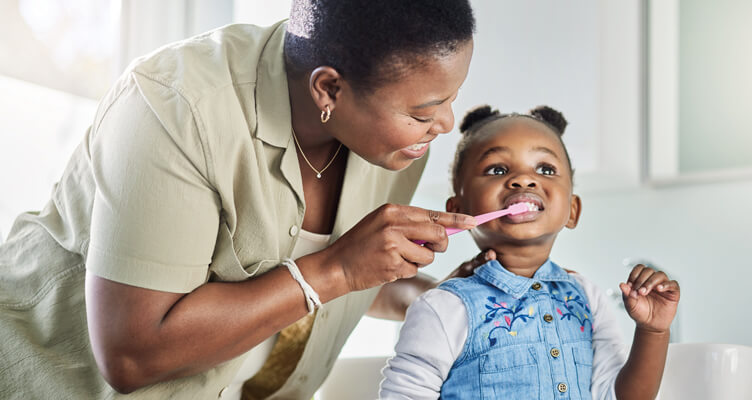Oral health pop quiz: true or false?
To say there is a lot of information on the internet would be an understatement. You can type anything into the search bar, and you'll have pages upon pages of results in seconds. But is it all true? Nope! Find out what is true and what is false.
False: Fluoride is an artificial ingredient added to toothpaste and water.

 Fluoride is a naturally occurring mineral found in most water sources like rivers, lakes and even some oceans.
Fluoride is a naturally occurring mineral found in most water sources like rivers, lakes and even some oceans. It’s often called nature’s cavity fighter and has been added to many public water sources for the last 70 years to assist with preventing tooth decay.
It’s often called nature’s cavity fighter and has been added to many public water sources for the last 70 years to assist with preventing tooth decay. Even before your teeth have erupted, fluoride taken in from foods and beverages can help keep enamel strong and more resistant to tooth decay.
Even before your teeth have erupted, fluoride taken in from foods and beverages can help keep enamel strong and more resistant to tooth decay.
True: Dental sealants can help protect against cavities for as long as four years.

 Dental sealants are a thin coating placed on the chewing surfaces of children’s back teeth (molars) to protect against cavities — and can last for four years or longer.
Dental sealants are a thin coating placed on the chewing surfaces of children’s back teeth (molars) to protect against cavities — and can last for four years or longer. Children between the ages of 6 and 11 without sealants have almost three times more first molar cavities than those with sealants.
Children between the ages of 6 and 11 without sealants have almost three times more first molar cavities than those with sealants. While sealants can do a great job guarding teeth against cavities, they’re not a substitute for daily brushing with fluoride toothpaste and flossing. Fluoride is essential for protecting the smooth surfaces of the teeth.
While sealants can do a great job guarding teeth against cavities, they’re not a substitute for daily brushing with fluoride toothpaste and flossing. Fluoride is essential for protecting the smooth surfaces of the teeth. During routine checkups, your dentist will make sure sealants are still in place and advise if they need to be replaced or repaired.
During routine checkups, your dentist will make sure sealants are still in place and advise if they need to be replaced or repaired.
False: Pregnancy doesn't influence oral health.

 Pregnancy can make you more prone to oral health conditions such as gum disease and cavities. It’s safe to continue to see your dentist for routine checkups, cleanings and dental treatments when pregnant.
Pregnancy can make you more prone to oral health conditions such as gum disease and cavities. It’s safe to continue to see your dentist for routine checkups, cleanings and dental treatments when pregnant. It’s important to keep up with healthy habits like flossing daily, brushing twice a day with fluoride toothpaste and eating a well-balanced diet.
It’s important to keep up with healthy habits like flossing daily, brushing twice a day with fluoride toothpaste and eating a well-balanced diet. If you suffer from morning (or any time of day) sickness, use a diluted mouthwash or mix 1 teaspoon of baking soda in a glass of water and rinse your mouth. This will wash away harmful stomach acid that could break down tooth enamel.
If you suffer from morning (or any time of day) sickness, use a diluted mouthwash or mix 1 teaspoon of baking soda in a glass of water and rinse your mouth. This will wash away harmful stomach acid that could break down tooth enamel.
True: Soft toothbrushes are more recommended than hard-bristled toothbrushes.

 Soft-bristled toothbrushes are easier on your gums and enamel than a toothbrush with stiffer bristles but still do a great job of removing plaque and debris.
Soft-bristled toothbrushes are easier on your gums and enamel than a toothbrush with stiffer bristles but still do a great job of removing plaque and debris. You can select either a manual or an electric-powered toothbrush with soft bristles. Just remember to change your toothbrush or your toothbrush head every three to four months or when bristles become worn.
You can select either a manual or an electric-powered toothbrush with soft bristles. Just remember to change your toothbrush or your toothbrush head every three to four months or when bristles become worn. Look for a toothbrush with a small head, angles and multilayers for a great clean, even in the hard-to-reach areas by your back teeth.
Look for a toothbrush with a small head, angles and multilayers for a great clean, even in the hard-to-reach areas by your back teeth.
False: Charcoal toothpaste is safe for everyday use.

 Charcoal toothpaste has grown in popularity to whiten teeth. However, you should discuss any new whitening treatments with your dentist before you start to make sure they’re the best and safest option for your teeth.
Charcoal toothpaste has grown in popularity to whiten teeth. However, you should discuss any new whitening treatments with your dentist before you start to make sure they’re the best and safest option for your teeth. Charcoal can be very abrasive and can wear down tooth enamel — the hard outer coating that protects your teeth.
Charcoal can be very abrasive and can wear down tooth enamel — the hard outer coating that protects your teeth. Most charcoal toothpastes also don’t contain fluoride — a key ingredient needed to keep tooth enamel strong.
Most charcoal toothpastes also don’t contain fluoride — a key ingredient needed to keep tooth enamel strong.
False: Putting a cap on your toothbrush prevents bacteria from getting to it.

 Avoid covering your toothbrush or storing it in a closed container, as this can cause bacteria to grow on it. This can also happen when a toothbrush is stored in a drawer or touching another toothbrush, as it won’t get the airflow needed to dry completely.
Avoid covering your toothbrush or storing it in a closed container, as this can cause bacteria to grow on it. This can also happen when a toothbrush is stored in a drawer or touching another toothbrush, as it won’t get the airflow needed to dry completely. To properly clean your toothbrush, first rinse it with clean water to get rid of any excess toothpaste. Then store it upright in the open air so it can dry out in between uses.
To properly clean your toothbrush, first rinse it with clean water to get rid of any excess toothpaste. Then store it upright in the open air so it can dry out in between uses.
False: You don't have to brush baby teeth.

 Once a baby’s teeth start coming in, brush twice daily with a soft-bristled toothbrush and a tiny bit of fluoride toothpaste to avoid early oral health problems.
Once a baby’s teeth start coming in, brush twice daily with a soft-bristled toothbrush and a tiny bit of fluoride toothpaste to avoid early oral health problems. You should use a smear of toothpaste (the size of a grain of rice) from the time the first tooth erupts until age 3. From 3 to 6 years, use a pea-sized amount of fluoride toothpaste for children.
You should use a smear of toothpaste (the size of a grain of rice) from the time the first tooth erupts until age 3. From 3 to 6 years, use a pea-sized amount of fluoride toothpaste for children. It’s highly recommended to take your child to the dentist for their first visit by their first birthday or six months after your baby’s first tooth appears.
It’s highly recommended to take your child to the dentist for their first visit by their first birthday or six months after your baby’s first tooth appears. While everyone eventually loses their baby teeth, it’s still crucial to keep them cavity- free. Maintaining a healthy smile will help your child avoid pain and help ensure adult teeth develop and erupt properly.
While everyone eventually loses their baby teeth, it’s still crucial to keep them cavity- free. Maintaining a healthy smile will help your child avoid pain and help ensure adult teeth develop and erupt properly.
Take a pause before believing something you find on the internet. And always check with your dentist or hygienist if you have any questions about your oral health.




